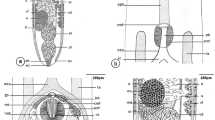Abstract.
Argentophilic staining and scanning electron microscopy were used to study the tegumentary papillae of Echinostoma caproni cercariae. The most abundant tegumentary papillae were uniciliate, but multiciliate papillae were also found, mainly on the ventral aspect of the oral collar. The distribution pattern of the papillae on the body and tail was in general similar to that seen in the cercariae of other 37-collar-spined Echinostoma species. Some differences were noted between E. caproni and the allopatric species, E. trivolvis. E. caproni has a greater number of papillae associated with the collar spines than does E. trivolvis. E. caproni has uniciliate papillae on the acetabulum, whereas E. trivolvis does not. Chaetotaxy is useful to distinguish subtle morphological differences in cercarial species in the 37-collar-spined Echinostoma complex.




Similar content being viewed by others
References
Fried B, Fujino T (1987) Argentophilic and scanning electron microscopic observations of the tegumentary papillae of Echinostoma revolutum (Trematoda) cercariae. J Parasitol 73:1169–1174
Fried B, Huffman JE (1996) The biology of the intestinal trematode Echinostoma caproni. Adv Parasitol 38:311–368
Fujino T, Fried B (1993) Expulsion of Echinostoma trivolvis (Cort, 1964) Kanev, 1985 and retention of E. caproni Richard, 1964 (Trematoda: Echinostomatidae) in C3H mice: pathological, ultrastructural and cytochemical effects on the host intestine. Parasitol Res 79:286–292
Fujino T, Ishii Y, Choi DW (1979) The ultrastructural characterization of the tegument of Clonorchis sinensis (Cobbold, 1875) cercariae. Z Parasitenkd 60:65–76
Higo H, Fujino T, Ishii Y (1980) The surface ultrastructure of Paragonimus westermani cercariae. Jpn J Parasitol 29:399–408
Huffman JE, Fried B (1990) Echinostoma and echinostomiasis. Adv Parasitol 29:215–269
Karnovsky MM (1965) A formaldehyde–glutaraldehyde fixative of high osmolality for use in electron microscopy. J Cell Biol 27:137A–138A
Kostadinova A, Gibson DI (2000) The systematics of the echinostomes. In: Fried B, Graczyk TK (eds) Echinostomes as experimental models for biological research. Kluwer, Dordrecht, pp 31–57
Krejci GK, Fried B (1994) Light and scanning electron microscopic observations of the eggs, daughter radiae, cercariae and encysted metacercariae of Echinostoma trivolvis and E. caproni. Parasitol Res 80:42–47
Toledo R, Munoz-Antoli C, Esteban JG (2000) The life-cycle of Echinostoma friedi n. sp. (Trematoda: Echinostomatidae) in Spain and a discussion on the relationships within the ″revolutum″ group based on cercarial chaetotaxy. Syst Parasitol 45:199–217
Author information
Authors and Affiliations
Corresponding author
Rights and permissions
About this article
Cite this article
Nakano, T., Fujino, T., Washioka, H. et al. Tegumentary papillae of Echinostoma caproni cercariae (Trematoda: Echinostomatidae). Parasitol Res 89, 446–450 (2003). https://doi.org/10.1007/s00436-002-0795-0
Received:
Accepted:
Published:
Issue Date:
DOI: https://doi.org/10.1007/s00436-002-0795-0




